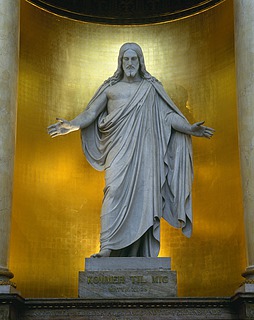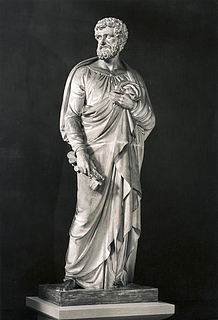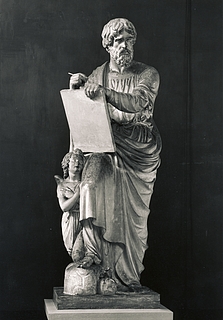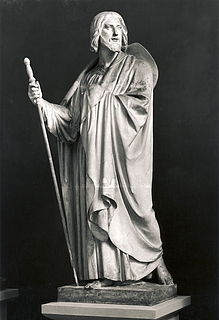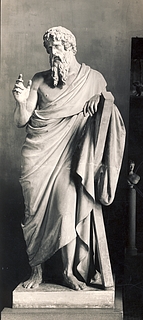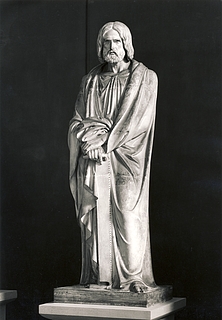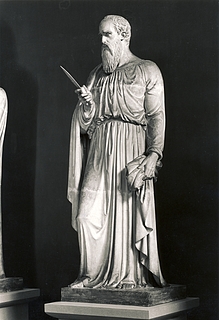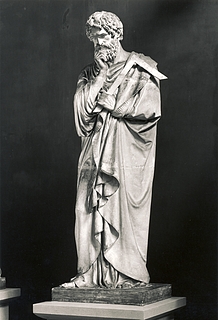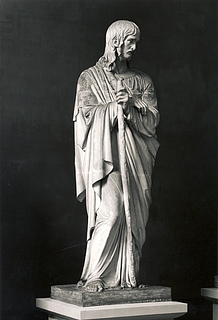Thorvaldsen’s Christ
and the
Twelve Apostles
in the Church of Our Lady (Vor Frue Kirke)
Copenhagen
Inspired Description
by
Emilie E. Douglas
Translation by Elisabeth Douglas
1934
Editor Georg Douglas
Published By The Editor
Copenhagen, July 13, 1842
I have been here since 9 o’clock in the morning of the day before yesterday and have been so active in seeing things that I have hardly had time for reflection–the more so as the one thing I look at again and again leaves me no real peace of mind for anything else. This one thing is the Church of Our Lady. I do not mean the building itself! I am referring to the Apostles by Thorvaldsen. Without delay we went into the Church of Our Lady the day before yesterday, and yesterday and to-day as well, and over and over again, I long to see these statues, and nothing else. When I come from the Thorvaldsen Museum, I always go directly to these statues; when I come from his studio, I also go to them. Neither busts, nor gods, nor figures of men, not even his adorable bas-reliefs, hold my attention. I not only mean to say that these Apostles are the most beautiful representation of art that Copenhagen possesses–that alone would not be sufficient–but I also say that these Apostles are the most beautiful representation of the Apostles the world possesses, and neither Raphael nor Titian has painted them in so masterly a manner.
I have not seen anything the equal of these statues since I was in Seville and saw the Moses and St. Thomas by Murillo which kindled the flame of reverence in my soul. And what an advantage the painter has in his art, having the charm of colour, graceful arrangement, and the magic of light! What did Thorvaldsen have? A grey-white block of marble. Oh this Thorvaldsen! Angels must have served him at this work, because genius alone does not attain so much. I would like to go to Rome to kiss his hand, his holy and blessed hand, in gratitude for having given a work of such deep soul-inspired faith to our commonplace world, in which faith has sunk to a caricature,–a caricature of haughty intellect vainly calling itself research, a caricature of narrow minds who believe that they will find salvation in forms and formalities and who seek to turn the doctrine of the spirit into a doctrine of the letter.
Perhaps I may be able to give you some idea of that which is before my eyes in such perfection. Perhaps it will awaken in you a desire to see it for yourselves. That would be good, that would be the best thing I could do for you. With the Greeks it used to be considered a misfortune not to have seen Olympus’ Jupiter–the highest thought clad in the most perfect form conceivable. Should we think differently, we who claim to be so highly and thoroughly educated?
First of all I must admit that I do not at all know what the world of to-day really thinks of Christ. Some talk of a “Lamb”, others of a “non-historical Christ”. Some even deny his existence, and it may be possible that others call him a defrauder. Theology has confused and darkened faith just as jurisprudence has confused and darkened justice. I myself, like all ignorant people, feel totally indifferent towards the four faculties–philosophy, law, medicine, theology. Only the one question has at times aroused my interest, Why there should not be three faculties rather than four, since Philosophy always seems to me to be the fruitful germ in the body of the other three, constantly developing new life in them. In this way the fourth faculty would be submerged as the animus in the life of the other three.
Now, I only wish to say that I do not know what sort of a Christ-concept the world owes to the theology of to-day. To me he is the Saviour of the world who redeems us from evil, if we follow him in strength and in love;–and thus Thorvaldsen has known him! But this redeeming thought God conceived first, and Christ thought it after him and realized it in the world; and no other can equal him! Although some have come and have laboured in this respect, and have sincerely searched,–yet it has always been one–sided. They did not have that understanding which like the light is unlimited–encompassing and penetrating the universe.
I do not think that there has ever been a man of art, or science, or inspiration, or intelligence, but has had a onesided concept of Christ. Of men of the first category, like Raphael and Klopstock, I know this to be true. In the case of the others I infer it from the fact that “Lamb” or “nonhistorical Christ” are just as one-sided productions of the faculties as were ever produced by the arts. Neither was Thorvaldsen’s genius entirely sufficient for the Christ! His Christ is gentle, compassionate, spreading out his arms and saying, “Come unto me, all ye that labour and are heavy laden and I will give you rest;”–but the figure has not the power, the light, the strength which overcomes the world, which was the essence of his being, and by which the twelve apostles were inspired. In addition the face of the Christ is so bowed down, that one cannot look straight at it; it can be seen only from below, if one is standing before the altar; and in no position can one gain a glimpse of his eyes.
It is often thought that statues do not look at us but this is not true! Thorvaldsen has shown that the eyes of statues have sight and colour. Paul looks at me with eyes golden as the light of truth. James has eyes like two blue naphta flames of unquenchable love and trust. Simon has eyes as black as mourning, and Peter’s eyes are of an iridescent grey like the ever moving sea of his soul. Truly, statues have eyes just as figures in a painting have a back. The Christ has been placed in a gilded niche above the altar on the assumption that thereby the figure would stand out, but instead the niche overshadows and oppresses him. If a statue is not intended for a niche and is not made especially for such a space, the niche will always give the impression of being too narrow. The marble of all these statues is very grey; in the niche it looks quite dark and dreary. Strangely enough, the figure of Christ is the most imperfect one and the work the least beautiful; the arms show defects. The head is of an idealistic tenderness. I always had the feeling that I would like to cover the Christ with a silver veil so that he would appear more glorious and more concealed at the same time, less marred by imperfection.
Before the altar there is a free space several steps higher which is separated from the nave by a balustrade; in the middle of it a kneeling angel is holding in his arms the baptismal bowl. With large snow-white wings on which the silvery glow of a higher light is still quivering and which show traces of a higher world, this angel has alighted. Its gracious head is beautifully adorned with a heavy wreath of imperishable flowers, for he is called to a high office! He brings the holy water to the young soul, as a symbol that it is pure when it comes from God and shall return to him pure. Kneeling with perfect devotion and gracious joy, he fulfills his heavenly mission, only straightway to fly back to heaven when once he shall have finished it, without one speck of earthly dust having touched his wings, his brow, or his feet, for it is quite apparent that he has brought with him from paradise a fragrant, purer, brighter atmosphere than that of our earth.
At the right and the left side of the altar in front of the six piers of the nave are the holy men whom Christ sent out into the world as his apostles to establish the heavenly Jerusalem while he and they were scorned by the earthly Jerusalem. And they did it faithfully unto death. To falter is impossible for these men, for like their Master they have overcome the world –but by what troubles, by what sufferings, by what superhuman strain, that show clearly upon their brows furrowed by grief and pain. Each one of them, from the old man to the youth, bears an expression of lofty melancholy; yet fully conscious of their mission, embracing both heaven and earth at one glance and with a step which is sure of its goal, they go their way, fully aware of its dangers. None of them is peaceful or joyful like the angel over there, because man belongs to another class of beings; to him glory is prepared not in joyful peace, but in ceaseless struggle. This conviction is the chief feature of all of them; they all have it in common and it gives them a touching sort of family-characteristic. Nevertheless, perhaps no artist has ever avoided monotony more fortunately than Thorvaldsen in the case of these twelve men clad in long garments, all wearing an underdress reaching from neck to feet and over this a wide coat, with the exception of Andrew who has only a coat. They hold in their hands the symbols commonly connected with them, that for which they lived or through which they died, the work of their glory or the implement of their torture.
O shame upon me! I know how Socrates, how Cato, how Epaminondas lived and died, but I do not know how these men lived and died, these men who surpassed the wisdom of Socrates, the strength of Cato and the nobility of mind of Epaminondas! John on Patmos, Peter in Rome, Paul on dangerous journeys, that is all that the Acts in the Bible and legends and paintings have told me of them. Probably no one knows much about them or any details, yet Thorvaldsen must have known, because there is a personal fate, an individual life, there are deeds and thoughts and pains belonging unmistakably to each individually, expressed in these figures, in these features. In the whole of modern art there is no other example, and only two or three in ancient art, of such penetration, such expression of the spirit of a subject in a block of marble.
To the right and left of Christ, at the top, are Paul and Peter,–intelligence and sentiment. Peter is holding the keys to the kingdom of heaven. His countenance changes with the impression that the two sayings of Christ make upon him: “Simon, son of Jonas, lovest thou me?”–and “Feed my sheep.” Sorrow at the well-founded doubt of the Saviour, and joy at his surprising confidence, both blending into the most profound, the most devout love, into a love which is so strong that it grows stronger than his weakness. A tear trembles on his lashes, his sensitive lips quiver with emotion. He feels like distrusting himself but does not dare to, since Christ is trusting him. With his left hand on his breast, giving as it were his heart to the Lord, he looks at him with such unspeakable gratitude as only that soul can know that feels reconciled with itself through a strange overflowing grace. The full lips, the emotional features, the short curls of his head and beard,– they all disclose the impetuous, passionate man who, however, can also be very steadfast as soon as the will is developed in him. His stature is entirely that of a man of the people, stout, with strong and broad shoulders as must be in the case with a poor fisherman who laboured hard in casting his nets and carrying them home. Neck and shoulders disclose hard work, a work, however, which makes the body strong but does not kill the spirit.
Opposite to him is Paul. He of course is of another caste. He was destined by nature to be a bearer of light; he was not destined for trade nor handicraft. He has never been in any other workshop but that of the spirit. The intelligence of this man rises straight up like a flame. It could be mistaken, it could draw from impure elements, work with ignoble materials –but all this with the deep fervor of conviction. When the understanding came, when truth destroyed error, when God threw his idols into the dust, the fervent persecutor Saul became the fervent confessor Paul. His spirit, his will and his energy remained the same; they were only purified, refined and elevated in the degree that the new doctrine was purer and higher than the old one. From the moment that he accepted it, he devoted himself to it, without wavering, without doubt, and with inward certainty. He was always and wholly just one thing. Paul was perhaps the most influencial apostle of them all. Nobody can say that he regretted his past, for although there was error, yet there was no lie in it. But a majestic sadness never left him. Grasping the new doctrine with the full power of his intelligence, he at the same time comprehended man with his innumerable contradictions so deeply, so exactly, that he needs must recognize how frail the weak vessel was for such weighty contents. The man who said: “That which I would not, that I do”–cannot possibly be otherwise than full of a lofty sadness. There he stands, the teacher, with shining brow and eloquent lips, with wonderful, noble features radiating intelligence, no trace of uncertainty or darkness. His tall, slender figure looks as if it were lifted up from the earth. The firm, clear, well-formed hand has never performed a lowly task; with exhorting and explanatory movements it follows his words. The shoulders are fine and bent; they have never carried material burdens. He is undeniably the cultured man, just as Peter is a man of the people; and the spiritual emotion of both is according to their position; it gave to the one the reasoning intelligence and to the other the passionate feeling.
Next to these foundation pillars of the church are two Evangelists, John and Matthew,–inspiration and meditation. With deep, powerful eyes Matthew looks directly into the world. His mouth is firmly closed. All his thoughts are concentrated on the task of repeating every feature of the wonderful life he has seen and every word of the wonderful doctrine he has heard. His right foot rests upon a stone so that his knee is raised. On the stone and on the head of his sweet angel who kneels beside him to perform this service for him, rests the great tablet, which he holds with the left hand, while the right hand is ready to write down all that he has experienced, seen and heard as a disciple of the Saviour, and which he is to repeat with holy conviction.
John, placed opposite to him, does not meditate, does not go back to memory. With face uplifted, and softly opened mouth, he listens to a higher voice which dictates to him what he is writing on the little tablet he is holding easily in his left hand. The hair is smoothly parted, cut short at the throat .and neck; his chin is beardless. His coat, held together with a clasp in the middle of his breast, is arranged in long straight folds at both sides. The eagle rests quietly at his feet. Quiet’, unmoved, untouched by any earthly emotion are both the figure and the soul which is in contact with a higher spirit. No trace of feminine beauty, nor of the soft tenderness which artists are so apt to portray in John, because he repeats over and over again: “Love one another.” As if only a woman’s soul could express love in religion. No! Thorvaldsen has honoured his sex. No one loves as well as he who is strong; therefore John is a strong youth who is able to carry the weight of revelation and who can penetrate on eagles’ wings into the secrets of a heavenly future.
His brother James is standing beside him. They were “The children of Zebedee” as we read in the Gospels. They and Peter were together with Christ on Tabor and were witnesses of his transfiguration. They and Peter were together with him in the Garden of Olives and slept, while he wrestled with death in prayer. “Can no one watch with me?” he asked sadly. No one could do it! The higher the soul has soared the lonelier it is in its agony! How this negligence must later have gnawed at the hearts of the disciples! And do not we, all of us, do the same in big and little things?–neglecting love, and worrying ourselves half dead when it is too late? –it was also the children of Zebedee who asked Christ, if a rain of fire should not destroy the place that was inhospitable to him. Certain it is that James put this question! This fiery soul knows only action. With staff and pilgrim’s hat he goes throughout the world, equipped to perform miracles in the name of the Lord, and positive of making him known to the world. He is the only one of all of them in whom the burning courage of faith vanquishes all the shadows of sadness and grief and transforms his countenance into a sun, before which there are no clouds. He is not only strong, firm, courageous, but also daring, and a joyful warrior in the battle of faith. The helmet of the warlike archangel would be beautiful upon this glowing brow, if it would not be infinitely more beautiful that he should wander bare-headed amid the storms and lightnings of the world,–lightnings which threaten him as they do all high things; for the pilgrims’ hat has slipped down from his heavy long hair, and hangs carelessly over his left shoulder. His garment is gathered up a little so that the foot is free; the coat is held before the breast by the left arm so that the step is not hindered. What a step! If the way should lead over burning coals, he would not notice it!
Opposite James is Philip; a man bordering on old age who, with an expression of complaining sadness, which long life together with acquaintance with the world is likely to give, looks on those who struggle against the tide. He has come out of it and is safe in the protection of the cross which, made of thin reed, he carries in his right hand like a dear memory.
Leaning on his cross, his terrible instrument of martyrdom, we see Andrew. He has had to fight many battles to arrive at this point! That he is the brother of Peter means something. Many a downfall and many regrets may have pulled at his heartstrings with iron and golden chains, as it were, until at last he crucified his human self and then was able to lean upon this cross as upon a pillar.
More quiet, less passionate, younger, Judas Thaddeus stands beside Andrew. His hands are clasped around a spear as in unceasing prayer. For all of these holy men had to be warriors, the aged man and the youth alike, the gentle one as well as the fervent. They all had to war against sin and lies; and just as certain as was their victory, was their troubled life and tragic death. Judas Thaddeus led a life of prayer which like the morning glow is reflected in his face.
Darkness is in the face of Simon. His eyes are as black as the night and sad as the night is his brow. The morning star of hope is always very low in his heart. True, he can rest his soul in this holy star, but this does not illumine the world for him, and the paths he has to traverse remain dark. His faith gives him strength and determination but not peace and joy. With what an unconquerable determination he stands there, his hands crossed on the saw which is to torture him; gazing into a future which will not be radiant for him, because he will humbly say: “I am an unworthy servant and have only done my duty.” How the deep thoughts dawn behind his furrowed brow, thoughts which evidently are the result of a heavy heart, heavy with melancholy sadness over the sins of the world, but not over his own debt! His is the fate of all men of a strong heart–whether they be apostles or not–he has to bear a heavy burden. He is a wonderful man, in the early autumn of life.
Bartholomew, opposite to him, is an old man. The sunken features, the scanty hair, the figure heavy about the hips, the bent knee–all this indicates age. It probably will soon be his turn to fall into dust for he is nearing the grave. With composure he looks upon the broad knife which is to tear the failing figure; the frailty of age fades out before the poise of the apostle.
A handsome man with a measuring rule over the left shoulder stands next to him, Thomas, the doubter. As a youth, man has not yet learned to doubt, and in old age, man doubts no longer,–but in full manhood the man must fight it. His spirit, his soul, all his capabilities and talents, every promise and every experience must be thrown into the melting pot of trial and the flame of doubt be kindled, in order to separate the pure gold from the ashes. No tendency of human nature is unknown nor fails of being understood in this group, and each tendency is ennobled through the deep yearning for truth. Thomas is wrapt in his coat and his thoughtful, intellectual, noble head is supported by his right hand with the arm bent, while his large eyes from under the shaded projecting brows rest upon their object with inquiring tenderness.
And finally James the younger, with his tender features, his long soft hair, the careless hands holding a strong staff or being held by it, dreamily gazing beyond the world into a brilliant eternity.
Where in all the earth, in what museum, in what temple of art, can one find such a company, which does not and cannot awaken anything but the noblest and best feelings in the soul of the spectator! Once again I was perfectly happy; but happy in my own way, abased to the dust as an individual, lifted to heaven as a being of the same race with these figures of light.
If the way in which Thorvaldsen brings to life a block of marble is worthy of reverence, his method in working it out is not less worthy of admiration. He is a Prometheus, but still more noble; he has the heavenly fire at his command, but has not stolen it, for he is at the same time a workman who executes his difficult task with most patient application and gives to the countenance, the limbs, the clothing, to every smallest detail, its full expression.
I have sometimes heard it said that the nude human body is the true object for sculpture. This is said solely by those who consider art only in its outward form. Because the most beautiful statues of the Greeks are nude according to the idea which they symbolize, and because so far Greek sculpture has been the unattained model of modern art, the self-opinionated believe that the nude must also be the perfect. This strange mistake was the cause for the “Naked Night” by Michelangelo, also for the nude bodies of kings in the Mausoleum at St.Denis. A genuine artist,–I mean one who understands the unity between body and spirit, between expression and the idea, which we see in Minerva springing out of Jupiter’s head,–will always know how to find the right subject for his art. A figure is not better suited for sculpture, because it is scantily clothed; the point is whether or not moral beauty can be expressed through it, whether or not it can be made a symbol of lofty, powerful and holy sentiments. Niobe in her unspeakable grief is so little affected by her robes that she is as beautiful as the Psyche in Naples, as beautiful as Venus of Milo. And the Apostles have this same spiritual beauty. They do not wear their garments as a burden or as a covering, but as a vesture which is part of them and in which they know how to walk, how to stand and how to behave themselves without restraint or study. The draped coat of the forward-stepping James can be drawn by three lines and it is unsurpassable in its simplicity and truth. The material of the undergarments is clearly distinguishable; the linen sleeves of Thomas, of James the younger, with their smooth wide folds, and the short and broken folds of woollen material in the sleeves of Paul. Everything is worked out to the minutest details, the hair of the head and beard, as well as the toe-nails; the step which is hardly visible under the gather–ed robe of James, and the border which forms the hem of Thomas’ coat.
The man who daily unlocked the door of the church for us and who may have wondered a little at the intense attention which I gave to the statues, asked me to-day which one I preferred. When I went up the middle aisle which leads to the altar, for the first time, a man with shining countenance passed me, motioning to me, as it were, to follow him. This man was the apostle James. The action in the eternal calm of the stone is perhaps the highest wonder in sculpture. That is why I said “James”. “Really?” he said, “no one has ever said that before; English people love John the best, the French love Peter; we are undecided between those two and Paul, but Thorvaldsen himself likes James the best.”– I rejoiced!!–Oh, Thorvaldsen has soul, a penetrating eye for the great as well as the small; he feels everywhere the pulsation of one sacred life! In this presentation of the Saviour and his disciples he has gone through the cycle of the most exalted feelings of which man is capable: immortal hopes, transfigured pain, sanctified strength, burn in these hearts, and all spiritual gifts such as discernment, science, intelligence, devoted to the highest sphere of human thought, dwell behind these brows; and every least little earthly frailty is cleansed in the sea of divine love into which it is dipped by their fervent faith.
And the man with these exalted ideas has also made the little bas-relief there above the collection box for the poor: a half-naked child wandering out i.nto the world with folded hands, while a guardian angel follows him, spreading over his head a protecting hand. Thus he himself went out into the world as a poor boy protected only by his genius. It is unmistakable that in this little work he has thought of himself. But is it not heavenly that he, the first artist in Europe, the great and celebrated master, the aged man crowned with glory, thinks of himself only in deep humility as the poor boy who is the protege of genius? “Do give me back what has been given you I” says the world-spirit to Astralion. Thorvaldsen surely is an Astralion.
Oh! I am tired, and quite exhausted,... not from admiring but because I have tried to explain to you what I admire, and the more deeply and truly I would like to do it, the more it exhausts my soul. In such moments death must be sweet. The soul is so absorbed in thoughts of beauty and perfection, that it can believe in its own perfection.
